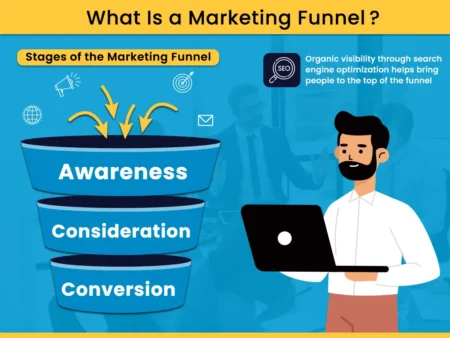
Understanding the Concept
For businesses in Tampa, internet marketing and SEO service strategies often rely on structured approaches to attract and convert customers. One of the most widely used frameworks is the marketing funnel. This concept illustrates the journey that potential customers follow, from the moment they become aware of a product or service to the point of purchase and beyond. It provides a straightforward way to organize outreach, engagement, and sales efforts.
The term “funnel” reflects the idea that many people enter at the top, but only a portion moves through each stage to reach the bottom. Understanding how each stage functions can help businesses design targeted campaigns that match the needs and behaviors of their audiences.
Stages of the Marketing Funnel
Most marketing funnels have three main stages: the top, the middle, and the bottom. Each stage means a different level of interest and engagement.
Top of the Funnel (Awareness)
The goal at this point is to capture people’s attention and raise awareness. This typically involves undertaking various strategies to reach a broad audience, including content marketing, search engine optimization, social media engagement, and paid advertising. The goal is to get a brand or product in front of a large audience who may not have shown any interest yet.
Middle of the Funnel (Consideration)
The consideration stage occurs after people become aware of a product or service. In this case, the focus is on building trust, relationships, and education. Businesses often use case studies, webinars, email marketing, or detailed product information to address questions and resolve problems that customers may encounter. At this point, prospects evaluate their options and determine if a particular solution will meet their needs.
Bottom of the Funnel (Conversion)
The final step is all about motivating people to take action. Prospects are nearing a decision, so strategies often include personalized offers, free trials, consultations, or incentives to encourage them to take action. The goal is to make the transition from interest to commitment a smooth and engaging process.
Beyond Conversion
Modern marketing funnels typically extend beyond the initial sale. After the purchase, there are subsequent stages, including retention, loyalty, and advocacy. Customers who receive excellent service and consistently high value from a business can become repeat buyers and enthusiastic promoters. These later stages of growth include receiving positive reviews, offering referral programs, and maintaining responsive customer support.
Digital Tools That Support Funnel Strategies
As digital marketing has grown, funnel strategies have become easier to measure and change. Organic visibility through search engine optimization helps bring people to the top of the funnel. For middle-funnel activities, email marketing platforms and customer relationship management systems track engagement and categorize people into groups. Analytics tools monitor conversions and help enhance strategies at the base of the funnel.
Automation is also essential. Automated workflows can enhance the customer experience by sending personalized messages, responding to leads promptly, and following up at the optimal time. This ensures that potential customers receive the same information at every stage without needing to be manually contacted repeatedly.
Aligning Content With Each Stage
To make a funnel work, you need to match the content to the right stage. At the top, blog posts, infographics, and social media updates should all focus on raising awareness. Middle-stage content should provide more detailed assistance, such as success stories or step-by-step guides. Bottom-stage materials should make things easier and help prospects make informed decisions. By aligning content with audience intent, businesses can guide people more efficiently through the sales funnel.
Common Challenges
Many businesses struggle to determine where potential customers drop out of the sales funnel. Some people may put a lot of effort into raising awareness, but not enough into follow-up plans. Some people might have outstanding bottom-stage offers, but they don’t build trust until later in the process. Regular analysis helps identify areas that need improvement, allowing you to make targeted adjustments specific to those areas.
Another common problem is treating the funnel like a solid structure instead of a flexible model. In real life, customer journeys can be complex, with paths that aren’t linear or straightforward. A successful funnel strategy takes these differences into account by keeping people interested, retargeting them, and changing the content as needed.
Why It Matters
The marketing funnel is more than just a picture. It provides a helpful framework for planning campaigns, allocating resources, and evaluating their effectiveness. Businesses can create plans that meet potential customers where they are and help them achieve meaningful results by understanding how they progress from awareness to action.
Bringing It All Together
For companies seeking to enhance their Tampa internet marketing and SEO services, mastering the marketing funnel can yield measurable benefits. It organizes outreach, nurtures leads, and supports conversion goals in a structured way. When each stage is addressed with the right mix of content, communication, and technology, the result is a more effective path from discovery to loyal customer.
If you would like professional support in building or optimizing your marketing funnel, consider working with Local SEO Tampa to create a tailored approach that aligns with your business goals.


